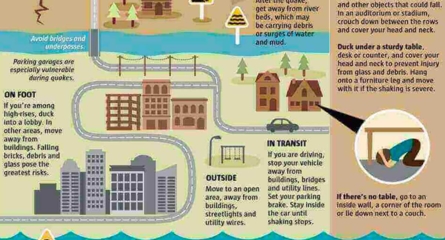Are you ready for the Memphis earthquake?
Memphis lies adjacent to the New Madrid Seismic Zone aka New Madrid Fault Line. The zone is a series of faults and secondary fractures that extend from Marked Tree, Arkansas into southern Illinois and has produced epic temblors in the past.
In late 1811 and early 1812, within the New Madrid Seismic Zone, a series of powerful jolts believed to range between 7.0 and 7.7 in magnitude were felt as far away as New England. They formed Reelfoot Lake, forced the Mississippi to briefly flow backward, and caused widespread liquefaction of subsurface soil. These historical quakes still rank as some of the largest in the United States since its settlement.
Small temblors still happen all the time. Hundreds of tiny earthquakes, most too small to be felt at the surface, reverberate through the seismic zone each year. Scientists still aren’t sure why quakes occur in the region, despite decades of studies by the University of Memphis Center for Earthquake Research and Information and similar institutions. The New Madrid zone lies far from the continental plate boundaries where temblors typically occur.
The potential hazard this seismic zone holds is great. According to the U.S. Geological Survey, there is a 7-10% chance that quakes between 7.0 and 7.7 will occur again within the next 50 years and a 25-40% risk of a low-6. A Federal Emergency Management Agency computer simulation from more than a decade ago found that a 7.7-magnitude quake could kill between 3,200 and 4,300 people, leaving another 70,000 or so injured.
During the past 25 years, building codes in Memphis and Shelby County have been gradually upgraded to require stricter seismic construction standards. But many older buildings, particularly in the Downtown area, are masonry structures built long before seismic requirements and are believed to be highly vulnerable to shaking from a quake.
Create a family emergency plan
- Hold a home evacuation drill
- Choose a nearby meeting place
- Have a plan for reuniting
- Anticipate transportation failures
- Designate an out-of-state relative to be a check-in contact for everyone
- Mobile apps, like the Red Cross’ earthquake app, can allow family members to communicate
- Keep photos of family members and pets in your wallet, in case they turn up missing
- Text messages often go through when phone service is down
Know your utilities
Water
Turn the water off if there is obvious leakage or if there is chance water lines are damaged. Damaged lines can lead to contamination. Wait for notification that lines are OK before turning it back on.
Electricity
If you see sparks, damaged wires, or smell burning insulation, switch the power off at the main breaker or fuse box. During a prolonged outage, leave a single light circuit switched on. That way you’ll know when the power is back.
Gas
Turn the gas off only if you hear hissing or smell gas. Once turned off, gas can only be restarted by a trained technician. Attach a wrench to your gas meter so it will be handy. To shut off the gas, turn the valve until it is perpendicular to the pipe.
Prepare Your Home
Create an emergency kit
If you do nothing else, be prepared to spend 7-10 days without utilities, medical help, or communications. Keep a family emergency kit and store it near a door for easy access. Make sure everyone knows its location.
Basics
- Water
- Flashlight
- Extra Batteries
- Nonperishable Food
- Can Opener
- First Aid Kit
- Cash (in small bills)
- Survival Handbook
- Pocket Knife
- Portable Radio
- Plan on one gallon of water per person, per day. Water-purification tablets or a back-country filtering device can be helpful in case water supplies are contaminated.
- Rope, plastic sheeting, and duct tape can be used for covering broken windows and other temporary repairs.
Tools
- Crowbar
- Axe
- Pliers
- Hammer
- Screwdriver
Helpful Items
- Paper Towels
- Toilet Paper
- Plastic Dinnerware
- Trashbags
- Aluminum Foil
Toiletries
- Routine Medications
- Pet Food And Supplies
- Soap
Shelter
- Tent
- Sleeping Bag
- Camping Stove
Protection
- Goggles
- N95 Dust Mask
- Work Gloves
- Heavy Shoes
After it hits
- Check for hazards such as fire, leaks, chemical spills and precarious structures.
- Be cautious in damaged buildings, and assess the conditions outside before exiting a building.
- Stay away from downed power lines.
- Provide first aid and a safe place for anyone who is injured.
- Call 911 or other emergency phone numbers only to report life-threatening emergencies. Phone lines will be jammed, and increased calls can hamper rescue efforts.
- Avoid moving severely injured people unless necessary.
- Stockpile water. Your community’s supply may be limited due to broken mains. Fill your bathtub. Be prepared to treat, filter or boil contaminated water.
- Eat refrigerated food first, frozen food next and dried or canned food last.
- If the electricity is out, open the refrigerator and freezer doors only when necessary. Refrigerated food should be OK for about 6 hours; frozen food should be safe for up to 48 hours.


